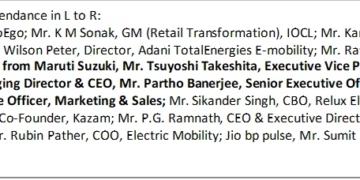Oct 02, 2025-
Volvo Cars reached an important milestone in its electrification journey in September, as it delivered its one millionth plug-in hybrid.
The company is transitioning towards becoming a fully electrified car maker, with plug-in hybrids (PHEVs) a significant pillar of the company’s growth today, as signified by this milestone.
PHEVs made up 23 per cent of Volvo Cars’ global sales in the first half of 2025. PHEV sales grew from almost 46,000 units in 2019 to over 177,000 units in 2024, underpinned by strong demand for the XC60 and XC90 PHEV in all three main sales regions.
The XC60 was the best-selling PHEV in Europe in 2024 and led the premium PHEV segment globally in the last three years. It continues to be a segment leader in 2025. Both the XC60 and XC90 were renewed last year, reinforcing their appeal in key markets such as Sweden, the US and China.
Thanks to the robust demand for its PHEVs, Volvo Cars has the highest share of PHEV sales of its total sales among all legacy premium car makers. It also continues to roll out new PHEVs, as demonstrated by the recently launched XC70 SUV, which is Volvo Cars’ first long-range plug-in hybrid with an electric range of over 200 kilometers under the CLTC testing cycle.
“Volvo Cars is committed to a fully electric future, and we will get there in a pace that suits our customers,” says Erik Severinson, chief commercial officer at Volvo Cars. “Our plug-in hybrid cars are a crucial bridge towards that future for those customers who are not yet ready to go fully electric.”
Internal Volvo Cars data shows that its PHEVs are often used as if they were fully electric, especially in urban areas. On average, drivers of Volvo PHEVs use their car without internal combustion power for around half of total driving time.
“While we invest and grow our presence in the growing premium fully electric segment, we will also continue to update and refresh our hybrids,” says Erik Severinson. “This allows more time for charging infrastructure to be built up, thereby easing the transition to a fully electric world.”
Volvo Cars has been a leading maker of plug-in hybrids for over a decade. It launched its first PHEV already in 2012, when it started selling a diesel PHEV variant of the V60 estate. For several years after, it was the only global car maker that offered a PHEV version of every model in its line-up.
It currently offers PHEV variants on five different models, which complement a line-up of six fully electric models. This balanced product portfolio provides Volvo Cars with a strategic advantage, allowing it to offer premium electrified cars in all shapes and sizes to global customers.
Volvo Cars reports September sales
Volvo Cars reported global sales of 63,212 cars in September, up 1 per cent compared to the same period last year. The total sales for the period of January through September amounted to 514,294 cars globally, a decrease of 8 per cent compared to the same period 2024.
In Europe, sales reached 31,723 cars in September, up 1 per cent compared to the same period last year. The sales of Volvo Cars’ electrified models decreased by 6 per cent compared to the same period last year, and the share of electrified models accounted for 61 per cent of all cars sold in Europe during September.
Sales in the US increased 3 per cent in September, totalling 8,758 cars. Sales of electrified models decreased by 21 per cent compared to the same period last year.
Volvo Cars’ sales in China reached 12,166 cars, down 6 per cent compared to September 2024. Sales of electrified models stood at 2,021 cars sold, an increase of 48 per cent compared to the same period last year.
In September, the Volvo XC60 was the top-selling model with sales of 20,496 cars (2024: 18,096), followed by the XC40/EX40, with total sales of 15,904 cars (2024: 13,930) and the XC90 at 8,252 cars (2024: 8,546).
| September | September | Jan-Sep | Jan-Sep | |||
| 2025 | 2024 | Change | 2025 | 2024 | Change | |
| Europe |
31,723 |
31,276 |
1% |
242,696 |
274,419 |
-12% |
| Electrified Models |
19,474 |
20,714 |
-6% |
148,887 |
178,645 |
-17% |
| – Fully electric |
9,939 |
11,760 |
-15% |
70,667 |
103,460 |
-32% |
| – Plug-in hybrid |
9,535 |
8,954 |
6% |
78,220 |
75,185 |
4% |
| Mild hybrids/ICE |
12,249 |
10,562 |
16% |
93,809 |
95,774 |
-2% |
| China |
12,166 |
12,915 |
-6% |
105,312 |
113,037 |
-7% |
| Electrified models |
2,021 |
1,363 |
48% |
11,562 |
9,982 |
16% |
| – Fully electric |
382 |
256 |
49% |
1,815 |
2,958 |
-39% |
| – Plug-in hybrid |
1,639 |
1,107 |
48% |
9,747 |
7,024 |
39% |
| Mild hybrids/ICE |
10,145 |
11,552 |
-12% |
93,750 |
103,055 |
-9% |
| US |
8,758 |
8,518 |
3% |
90,701 |
89,547 |
1% |
| Electrified models |
2,690 |
3,416 |
-21% |
27,897 |
29,762 |
-6% |
| – Fully electric |
1,009 |
666 |
52% |
8,612 |
3,755 |
129% |
| – Plug-in hybrid |
1,681 |
2,750 |
-39% |
19,285 |
26,007 |
-26% |
| Mild hybrids/ICE |
6,068 |
5,102 |
19% |
62,804 |
59,785 |
5% |
| Other |
10,565 |
9,749 |
8% |
75,585 |
83,919 |
-10% |
| Electrified models |












































